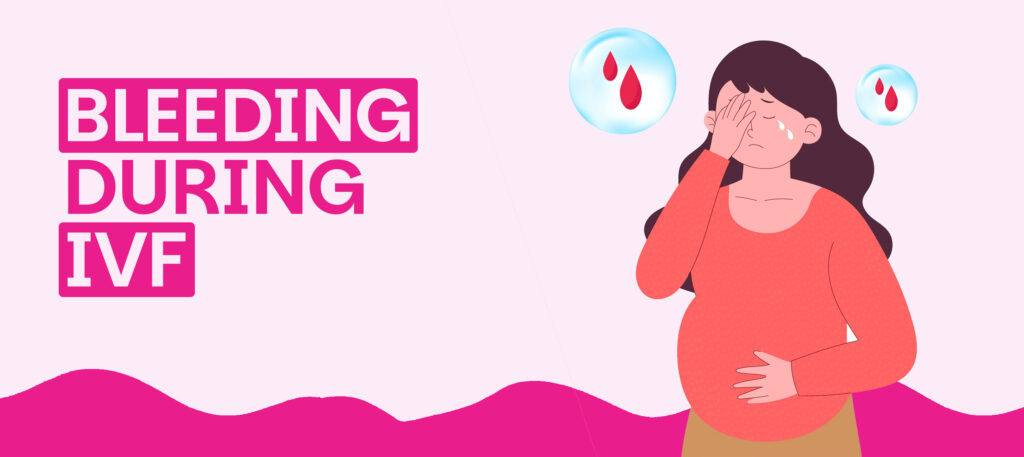Undergoing an IVF cycle is both exciting and emotionally overwhelming. Every small change—especially bleeding—can cause anxiety. Many women fear that bleeding means their IVF cycle is failing. The truth is, bleeding during IVF can happen and is not always a negative sign. At Vrinda Fertility, we guide our patients through every stage of their journey, helping them understand what’s normal, what needs attention, and how to respond.
What Happens During the IVF Cycle?
The IVF process involves multiple steps:
- Ovarian stimulation using hormones
- Egg retrieval through a minor procedure
- Embryo transfer into the uterus
- Luteal phase support with progesterone and other medications
At each stage, the uterus, cervix, and hormonal environment are affected. This makes spotting or light bleeding possible.
When Can Bleeding Happen During IVF?
1. Before or At the Start of the Cycle
- Normal menstrual bleeding signals the start of stimulation.
2. After Egg Retrieval
- Mild spotting may occur due to the needle passing through the vaginal wall.
- Usually light and temporary.
3. After Embryo Transfer
- The cervix may get irritated during the procedure, leading to pink or brown spotting.
4. During the Two-Week Wait
- Implantation bleeding can occur when the embryo attaches to the uterine lining.
- Appears as light, short-lived spotting, often pink or brown.
Common Causes of Bleeding in IVF Cycles
- Implantation Bleeding: Happens 6–12 days after transfer when the embryo implants.
- Hormonal Changes: Progesterone and estrogen may cause cervical sensitivity.
- Cervical or Vaginal Irritation: From scans, intercourse, or procedures.
- Uterine Conditions: Fibroids, polyps, or thin lining can increase bleeding chances.
- Subchorionic Hemorrhage: A small bleed near the placenta during early pregnancy.
Normal vs. Concerning Bleeding: Key Differences
| Feature | Usually Normal | Needs Attention |
| Amount | Light spotting or streaks | Heavy flow, soaking pads |
| Color | Brown or pink | Bright red, with clots |
| Timing | After retrieval, transfer, or during implantation window | Persistent bleeding beyond a few days |
| Symptoms | Mild cramps or none | Severe pain, fever, dizziness, fainting |
When to Call Your Doctor
- Heavy bleeding like a menstrual period
- Severe cramping with bright red blood
- Dizziness, fainting, or fever
- Bleeding that worsens instead of subsiding
- Bleeding after a positive pregnancy test
Early consultation ensures quick intervention and better outcomes.
Does Bleeding Mean IVF Has Failed?
Not necessarily. Many women who experience spotting during IVF go on to have successful pregnancies. Light bleeding, especially due to implantation or cervical irritation, can be harmless. However, heavy or persistent bleeding should never be ignored. At Vrinda Fertility, we use timely ultrasounds and blood tests (like β-hCG and progesterone levels) to assess your progress accurately.
How Vrinda Fertility Supports You
- Close Monitoring: Regular scans and bloodwork for reassurance.
- Personalized Care: Adjusting medications if needed.
- 24/7 Guidance: Access to your fertility care team whenever you need.
- Emotional Support: Counseling and patient care for stress management.
Conclusion
Bleeding during IVF is common, but its meaning depends on timing, flow, and associated symptoms. While light spotting may be normal, heavy bleeding should always be reported. At Vrinda Fertility, our team ensures you’re never left worrying alone—we guide, support, and provide expert care at every step of your IVF journey.
Frequently Asked Questions (FAQ)
Yes, it could be implantation bleeding, but only a blood test confirms pregnancy.
Yes. Progesterone and estrogen can make the cervix more sensitive, causing light spotting.
No. Light bleeding often occurs in successful cycles too.
No. Never stop or adjust medicines without consulting your doctor.
Some women experience spotting due to differences in hormonal preparation, but both fresh and frozen transfers can involve light bleeding.



